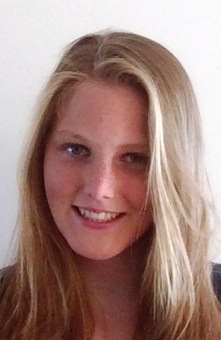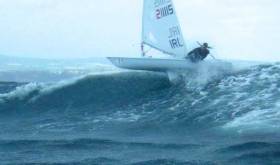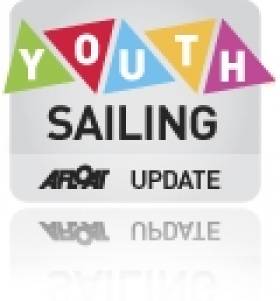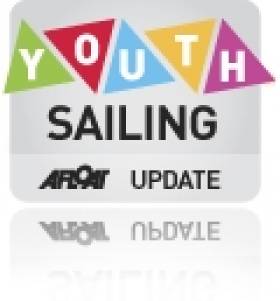Displaying items by tag: Lasers
When that definitive image of young Aoife Hopkins leppin’ her Laser with rocket power out of a breaking wave at the European Women’s Laser Radials Under 21 Championship 2017 (July 17th to 24th) at Douarnenez in Brittany went viral, we all knew something very special was going on.
But though the young Howth sailor clearly revelled in the heavy going, she proved well able for conditions of all sorts, and had the mental strength to withstand an entire crucial day lost to calm. With three races packed into the final day, she took three firsts to clinch the trophy by a country mile.
An outstanding Sailor of the Month for July among our potential Olympians.
 Aoife Hopkins
Aoife Hopkins
#youthsailing – In a major boost for Irish Laser youth sailing, Seafra Guilfoyle finished in sixth place from 155–starters at the European Laser Youth Championships in Denmark yesterday. The result is a promising indicator of form for this month's ISAF Youth Worlds in Portugal, in which Guilfoyle will represent Ireland also in the Laser class.
There were other top Irish results at the Danish venue too in both the boys and girls fleets.
Five Irish girls finished in the top 30. The girls, all under 19 years, completed 12 races over the week and finished in strong conditions with winds over 20 knots.
Erika Ruigrok finished in 10th position followed by 6 other girl sailors Aisling Keller 14th, Sorcha Ni Shuilleabhain 23rd, Sorcha Donnelly 27th, Sarah Eames 29th & Laura Gilmore 40th out of a fleet of 77 boats.
In the larger boys fleet of 155 boats. Guilfoyle was followed by Cian Byrne 20th, Liam Glynn 27th & Conor O'Beirne. 56th.
Disappointing End for Irish Lasers
Things unravelled for Dun Laoghaire sailor Matthew O'Dowd towards the end of the Laser Worlds in Largs, Scotland. Once the fleets were split into Gold, Silver and Bronze, O'Dowd's run of good fortune seemed to hit a brick wall. A 69th was followed by a black flag, and the fourth race in the final race saw him come home 40th. A third place in the penultimate race showed that O'Dowd was still capable of cutting it at the top, but with too many doubl-digit results, O'Dowd saw first top five, then top ten, then top twenty drift away. However, 33rd in a Gold Fleet of 73 is still a good result in such a competitive fleet, however consolations like that will not go far.
Alan Ruigrok followed O'Dowd in 44th, with Ross Vaughan in 49th. Ruth Harrington was top girl, 17th in the Silver Fleet, with Saskia Tidey finishing 34th.
Full results are HERE.
In the Standard Rig Europeans, Chris Penney kept himself in the golf fleet, finishing 55th overall. Results pdf is attached.
Top Five Start for O'Dowd
Fresh from a top ten finish at the ISAF Youth Worlds, Dun Laoghaire sailor Matthew O'Dowd has started the Radial Youth World Championships in Largs with a second place finish.
The Laser fleet numbers some 210 boats, and has been split in three for the initial group stages. O'Dowd's second place in his 70-boat group puts him in fifth overall and sets a good tone for the rest of the regatta.
The Worlds, held in Largs, Scotland, lost its first day to light airs and had to wait until late in the afternoon yesterday to get racing in, whena steady, building northerly breeze trickled down the Clyde this afternoon allowing racing to commence.
The conditions were far from what the senior Radial fleet experienced at their world championship the previous week when gusts of 40kts swept through the fleet, but adequate enough to allow the 320 competitors to enjoy the first tactical race of the series.
Sailing on ‘home waters’, it was good to see 16-year-old GBR sailor Elliot Hanson demonstrating why he is one of the hot favourites here this week. Hanson finished sixth on these same Clyde waters last week at the Laser Radial World Championships. A former Topper UK national and world champion he benefited from the leading Hungarian’s windward mark-rounding error, and enjoyed a good race with Matthew O'Dowd (IRL), to win the one and only race of the day on the Boys’ course. Tadeusz Kubiak (POL) was also on top form winning Blue fleet, while Matthew Mollerus (USA) has made his intentions clear by winning the Red fleet.
On the girls’ course, set further to the north of Cumbrae, the situation was equally exciting with Julia Vallo Arjonilla (ESP) winning the first race in the Blue fleet and finishing third in Race 2 which puts her in a leading overall position. Pauline Barwinska (POL) snatched a win in Yellow fleet when Marketa Audyova (CZE) who crossed the line first, was deemed OCS.
Barwinska, fresh from competing at the Volvo Youth Sailing ISAF World Championship in Turkey is another race sharp sailor who showed she’s a real force to be reckoned with. She’s only been competing at international level for one year, so today’s result has given her a massive boost. The Japanese girls are also on top form with Manami Doi, and Momoko Tada taking wins in the second races (Yellow and Blue fleets).
Elliot Hanson (GBR): “We had quite tricky conditions to start with because the wind was up and down. I was second round the windward mark and then managed to chop and change with Matthew Odowd until the last run when I just managed to pull away. We started off with the most wind of the day at 12kts from the north generally. There were more pressure changes than shifts. The key today was to keep the speed up and reach the first windward mark in a decent position. But I think staying in the highest pressure was the key factor of the day. Some of the other British sailors did well today too and Cam Douglas – who was at the ISAF event, and John Currie who was second at the Youth Trials – are definitely two I’ll be watching out for this week.”
Full results from the event are HERE.
Laser SB3 Ireland
Laser SB3 Ireland is the class association for the largest and newest Irish keelboat class. We have over 90 boats in Galway, Lough Derg, Dunmore East, Cork, Kinsale, Belfast Lough, Howth and Dun Laoghaire. We represent the full spectrum of age, (ranging from 20 to 70+) and skill sets (from Olympians to occasional club sailors) playing at all levels for big trophies throughout the country. We have five regional championships each year and vibrant local racing too.
What about the boat?
It’s as much fun you can have at 16 miles an hour. The SB3 is fast, furious and fun – but surprisingly stable and easy to sail. In the light stuff it sails upwind beautifully and is tactical downwind, in the heavy it’s a beast uphill and a roaring pleasure the other way. It’s truly one design – the best sailors always win, which, perhaps, is not so good for the rest of us – but the fun makes up for it. It’s added value, to most, is that is can be rigged quickly, towed by a normal family car, has a great price point and, finally, it can be both slip and crane launched.
What to do and who to talk to?
If you are interested in getting involved we can help. Contact your local fleet captain from the list on the contact page page and they can organise a test drive, recommend second hand boats and generally tell you all about it. If you’re new, selected members of the class will also help you get started with tips and tricks sessions.
We’ll see you on the water!
Laser SB3 Ireland, c/o Joseph Hughes, Class Chairman, 4 Clanbrassil Terrace, Dublin 8. Tel. 087 747 8883, email: [email protected]
There is a space for Irish boating clubs and racing classes to use as their own bulletin board and forum for announcements and discussion. If you want to see a dedicated forum slot for your club or class, click here



























































